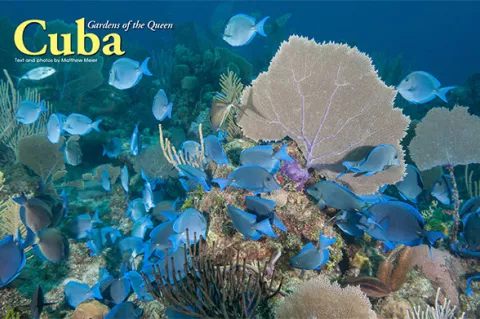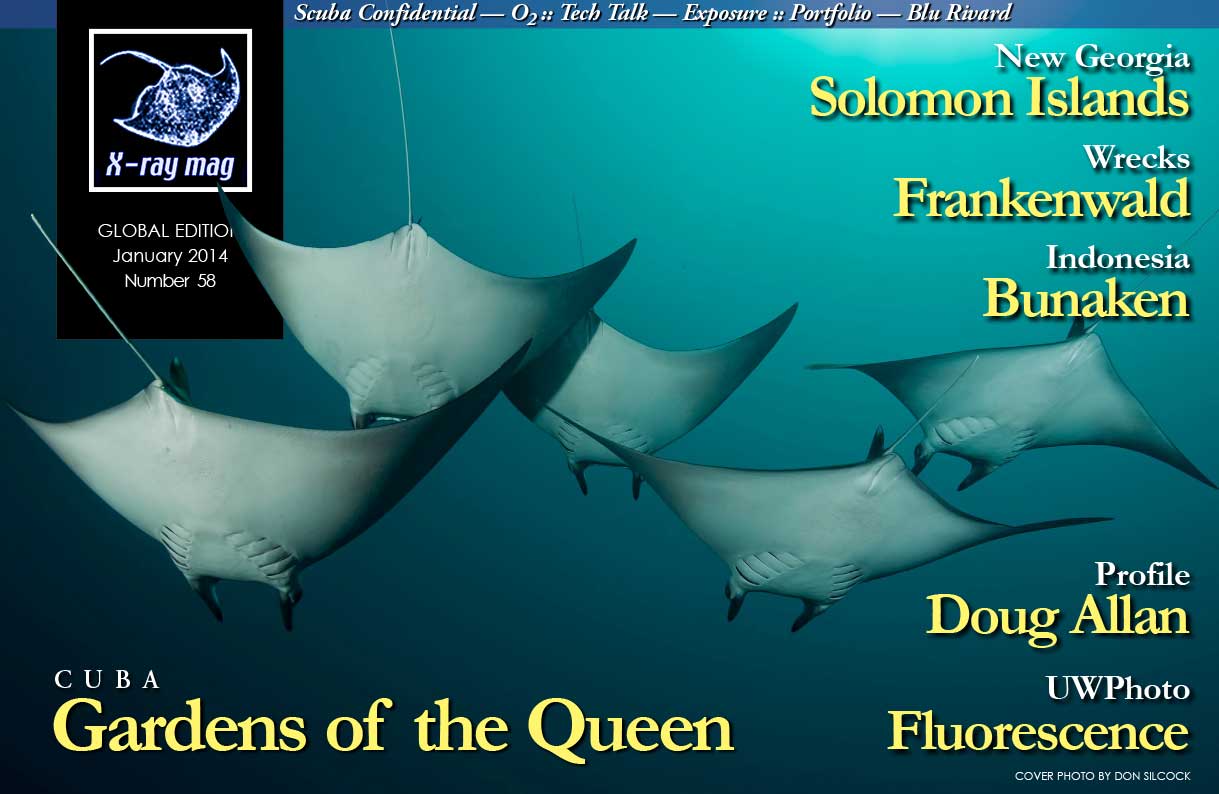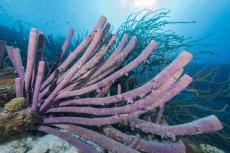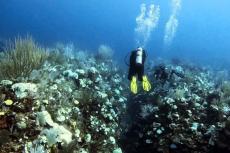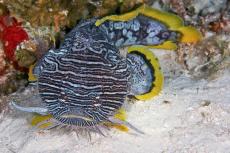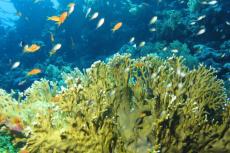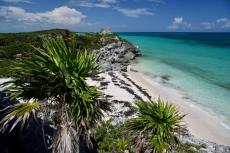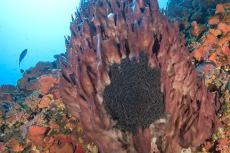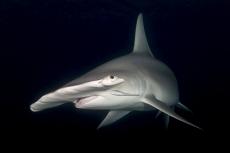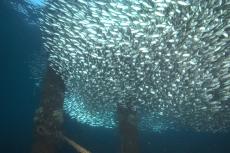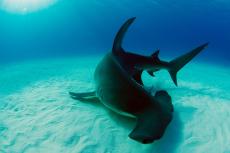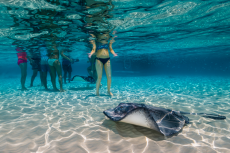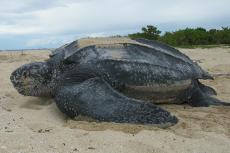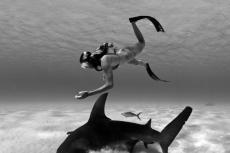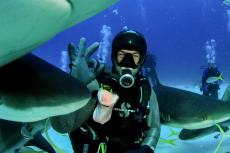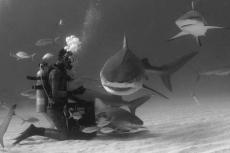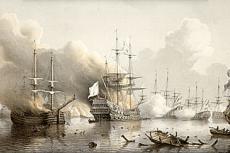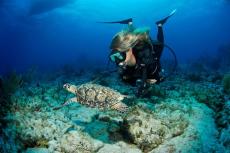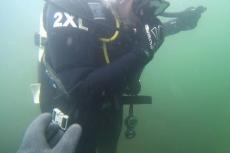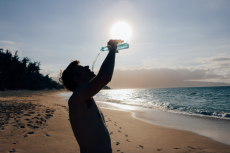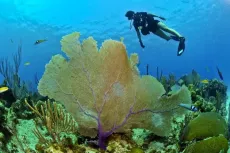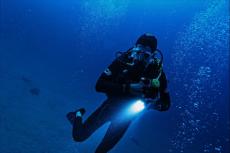As the wheels touched down at Havana’s International airport, the plane erupted with cheers and applause. Many of the passengers on board had waited years, if not decades, to return home and visit relatives in Cuba. As part of a small group of Americans visiting for the first time, I knew immediately that we were in for a special treat.
Traveling on permits from the U.S. Department of Treasury, we were embarking on a People to People Educational Exchange program, focused on ocean conservation, research and ecotourism—the first of its kind to allow U.S. citizens to legally travel and scuba dive in Cuba.
Contributed by
Factfile
Matthew Meier is a professional underwater photographer and travel writer based in San Diego, California.
To see more of his work and to order photo prints, please visit: matthewmeierphoto.com
Sources:
Oceandoctor.org/gardens
Cubandivingcenters.com
Wikipedia.org
Eyewitness Travel Cuba
Moon Handbooks Cuba
As the wheels touched down at Havana’s International airport, the plane erupted with cheers and applause. Many of the passengers on board had waited years, if not decades, to return home and visit relatives in Cuba. As part of a small group of Americans visiting for the first time, I knew immediately that we were in for a special treat. Traveling on permits from the U.S. Department of Treasury, we were embarking on a People to People Educational Exchange program, focused on ocean conservation, research and ecotourism—the first of its kind to allow U.S. citizens to legally travel and scuba dive in Cuba.
Our adventure began in Havana with three days of sightseeing, meetings and educational field trips learning about Cuba’s history and culture. Afterwards, we spent six days on a liveaboard dive boat at the Gardens of the Queen (also known as Jardines de la Reina) exploring the uninhabited archipelago of small islands 50 miles south of Cuba’s main island in the Caribbean Sea.
As we walked the streets of Havana, it felt like I had stepped back in time. Classic American cars from the 1950s and early 60’s were a constant reminder of a bygone era. Men gathered under large shade trees in city squares to discuss sports on a lazy afternoon and locals assembled around games of checkers and dominos on marble park benches or an apartment stoop. The newsstand still had Life magazine for sale on the bookshelves, and all around the city, building facades were carved in intricate detail. This was life as perhaps my parents remembered it, long before I complicated matters.
Mixed in with the nostalgia were reminders that Cuba is still a socialist country, struggling with their proud revolutionary history and capitalistic desires for a better life. Images of Fidel Castro and Che Guevara dot the landscape and armed soldiers stand constant guard at the Revolutionary Museum. Meanwhile, subtle signage on side streets, advertise businesses, such as hair salons and restaurants, inside private homes. These slowly opening doors to private capitalism are part of the small reforms put in place by Fidel’s brother Raul since he was handed power in 2008.
Havana has a pulse to it that is mesmerizing. I am certain that part of the allure was simply being in a place that we had been told our entire lives was forbidden. However, from the live music coming out of doorways and the Cuban jazz on rooftop bars, to the hustle and bustle of the locals going about their daily lives, there is an energy you can feel.
There is also a dichotomy that comes from seeing modern art deco structures next to baroque, intricately carved building facades that are hundreds of years old. Add in fortresses with working cannons, Cuban cigars, rum, exceptional food and friendly people, and you have a fantastic melting pot of experiences.
An American and Cuban cultural icon, Ernest Hemmingway, lived in Cuba from 1940 to 1960 and is still widely revered. His former home, Finca La Vigia, is now a museum, maintained as it was left upon his departure. His books remain required reading for Cuban school children. Novels For Whom the Bell Tolls and The Old Man and the Sea were written while living in Cuba, the latter earning him a Nobel Prize for Literature in 1954.
Hemmingway dedicated the award to the citizens of the fishing village of Cojimar, the setting for the story. We toured the village and it was fascinating to see his inspiration in person and realize that the old man was likely based on a real fisherman and drinking buddy of Hemmingway’s.
Cuba and Havana are still struggling to rebuild from the economic downturn encountered when the Soviet Union collapsed in the early 1990s. Years of electrical blackouts and limited fuel to run machinery or automobiles brought about food shortages and desperate times for a people accustomed to state provided nourishment and health care. Tractors gave way to ox and plows, and cars were replaced with horse-drawn carriages, as the infrastructure was ignored and left to decay in the tropical heat.
Fortunately, signs of rebirth and restoration were prominent during our visit. Scaffolding, providing face-lifts, surrounded many of the iconic buildings in old Havana. Cobblestone streets were torn up for new plumbing lines, and large cranes could be seen from the roof of our hotel. With over 3,000 structures in Old Havana of historical significance—the majority of which date back to the 19th, 18th and even the 16th and 17th centuries—resurrecting them all will be no easy task.
Marine research and educational exchange
While in Havana, we met with a scientist from the University of Havana’s Center for Marine Research. Founded in 1970, the center is responsible for training all marine biologists in Cuba. The scientist showed us an impactful ten-part public service announcement campaign created by the center, which highlighted the connection Cubans have with sharks, turtles, eagle rays, marine pollution, etc, in their surrounding ocean. We had discussions regarding some of their ongoing conservation research, including work with sharks, sea turtles and a five-year study on manatees.
As part of the manatee study, researchers were able to verify evidence of a manatee traveling from Florida to Cuba through photographs and also create a tagging and tracking program to study the local population’s migration patterns. Additionally, they found that none of the manatees that were documented had propeller scarring on their backs like their Florida counterparts, perhaps in part due to the limited number of boats allowed to operate off Cuba’s coast.
The lack of available watercraft also serves as a hindrance for student research. The University has but one boat and limited funding for sending scientists out to sea. We were able to tour that lone research vessel and talk with some of the researchers on board while out at the Gardens of the Queen. The boat, named after famed Cuban scientist Felipe Poey accommodates 17 passengers and three crew members. There is one shared head on board, and everyone sleeps in lawn chairs on the deck.
As part of the permit that allowed us access to Cuba, these people-to-people educational exchanges were required but also very enlightening. We learned that conservation and the environment are viewed in a very positive light in Cuba.
The government requires environmental permits for all businesses; they are reviewed annually and may also be revoked. Science directs politics in establishing policy and also aids in the creation of a National Environmental Strategy, which is improved upon every five years, based on analysis of the success and failure of the previous plan. Each new design focuses on reforestation, the reduction of pollution both on land and in the sea, and the protection of biodiversity.
Several of the scientists we spoke with also emphasized the importance of collaboration between the U.S. and Cuba on environmental issues. One even went so far as to declare the environment as a national security issue—especially with regards to marine pollution and species preservation, as we all share the same ocean.
In order to see some of this environmental conservation in action, we spent a day at Las Terrazas, a sustainable development community and ecotourism settlement situated roughly an hour west of Havana. Las Terrazas is part of the Sierra del Rosario, a nearly 100-square-mile expanse of pristine Cuban wilderness, which has been recognized as a UNESCO world biosphere reserve.
Started in 1967 as a government reforestation project—following years of land clearing for a coffee plantation, and later, charcoal—the roughly 1,200 residents have replanted over eight million trees, encompassing 24 different species. The surrounding hillsides are lush with vegetation once again, and the villagers utilize conservation-minded sustainable practices to ensure they stay that way.
Our guide led us on a tour of the grounds where we visited a primary and secondary school, community center, library, movie theater, restaurants, a hotel and Cuba’s only zip line facility. Local musicians entertained us during lunch, as peacocks and chickens wandered around the grounds. Afterwards, we called on a resident artist’s studio to see world-class eco-conscious paintings and handicrafts depicting climate change.
The Gardens of the Queen
Our journey from Havana to the Gardens of the Queen began at 4:30 in the morning with a five-hour bus ride through the countryside. Along the way we passed mountains, farms, small towns and miles upon miles of sugar cane, which is used to make Cuban rum. In the fishing village of Jucaro, we boarded the boat that would be our home for the next six days and spent another five hours traveling across the Gulf of Ana Maria and the Caribbean Sea to the Gardens of the Queen. The transit provided time to get settled into our rooms, assemble dive gear and camera housings and perhaps grab a short nap to make up for the early wake up call.
The Gardens of the Queen National Park was established as a marine protected area (MPA) in 1996. Consisting of over 250 coral and mangrove islands stretching across 75 miles of the Caribbean Sea, the park has a total area of over 830 square miles. Catch and release sport fishing is allowed within the 386-square-mile fishery reserve but otherwise, with the exception of lobsters, the area is a complete no take zone.
Additionally, visitation is limited to a mere 1,500 combined fishermen and divers per year. Birds, iguanas, hermit crabs and hutia occupy the islands, the latter being a medium sized rodent that nests in trees and is affectionately called a tree rat. The park is part of the Cuban National System of Protected Areas and is managed as an area of special care for special use.
Diving
The next day, as I gently slid into the water, I thought of all the technology necessary to allow us humans to survive in the underwater world and how truly out-of-our-element we are beneath the surface. I then warily scanned the surrounding sea grass for a prehistoric creature that has been living in harmony with water since the days of dinosaurs. The trepidation and excitement of being up close to an American crocodile was palpable. It is not every day that you come face to face with a living fossil.
As I cautiously made my first approach, the crocodile glanced in my direction and then lazily shut its eyes, as if already bored with our meeting. As I drew closer, the eyes opened once again, and it allowed me a few tight portraits before slowly rising to the surface for a breath of air and a scan of its surroundings. Thankfully, I had a few more opportunities to photograph the crocodiles, and those interactions were one of the highlights of my trip, but they were only the first of many big animal encounters while in Cuba.
We were fortunate to have Caribbean reef sharks swimming with us on nearly every dive. Rarely have I been in the water with sharks that did not turn and swim in the other direction in reaction to divers, but here, they ignored us and continued on their path.
The same could be said for the large number of groupers found on the reefs. I saw several variations of black grouper, along with tiger grouper and the endangered Nassau grouper, and for the most part, they were also indifferent to divers. In addition to the reef sharks, we had a couple dives where we hung in blue water beneath the boat as a dozen or more silky sharks swam circles around us. The sharks were attracted to the scent of a single fish placed in a steel box hung beneath the boat, and they stayed with us for over an hour providing terrific photo opportunities and exciting interactions.
Healthy reefs
The coral reefs in the Gardens of the Queen were the healthiest I have ever seen in the Caribbean. Everywhere you looked the corals, sea fans and sponges were incredibly robust, in great variety and thriving with fish life. Larger species such as tarpon, barracuda and snapper were a common sight and accompanied the many schools of grunts, tangs and creole wrasse on the reef.
The icing on the cake for me was at a dive site called Paradise Reef where we found huge colonies of beautiful elkhorn coral. These mainly shallow water corals are threatened and endangered throughout their range, and in some areas, their abundance has declined by 95 percent.
The Gardens of the Queen was Cuba’s first MPA, and its creation required the establishment of fishing licenses and an enforcement office, as well as the creation of jobs and retraining for the displaced fishermen. Many of those fishermen are now employed as sport fishing guides, boat drivers and dive guides within the MPA.
The area has been highly successful, as the ecosystem is abounding with healthy corals, large quantities of fish and marine life and abundant apex predators such as sharks and grouper. The evolution took time, yet the fishermen who are still fishing outside the reserve are realizing the benefits of an increased fish catch from the spillover effect, and the former fishermen are receiving comparatively higher wages by working in the tourism industry.
The success can be partially attributed to the parks location 50 miles offshore, the lack of commercial fishing, limited access and impact and effective enforcement. The Gardens now serve as an example for Cuba and abroad, touting the benefits of conservation and MPA’s. Subsequently, the Cuban government has been creating more marine protected areas, with the ultimate goal of safeguarding 25 percent of their waters—the most of any country in the world. To that end, efforts are currently underway to expand the fishery reserve and protect the remainder of the Gardens of the Queen as a no take zone.
Tidal flow
Diving conditions and visibility at the Gardens of the Queen are dependent on tidal flow. The direction the tide is taking the sediment from the mangroves determines which dive sites are best for that time of day. While we were there, we typically had better visibility on our two morning dives and deteriorating visibility in the afternoons. We were also there at the end of the rainy season, which meant late afternoon thunderstorms but made for incredible sunsets. There was the possibility of seeing whale sharks on our trip, as they are found in the area around the full moon in October and November but unfortunately we struck out.
Diverse ecosystems
On a few of our surface intervals we had the chance to snorkel amid the mangroves and surrounding sea grass. I found several species of corals and anemones that I had not seen on the outside reef, along with upside down jellyfish, sea stars, sting rays and plenty of juvenile fish seeking protection in the mangroves root structure. At one point, I was staring face to face with a three-inch barracuda, quietly cursing the fact that I did not have a macro lens on the camera.
While the mangroves serve as a nursery for many species of fish, the deserted beaches of these remote islands serve as critical nesting sites for hawksbill sea turtles. Thankfully, Cuba no longer harvests turtles as a commercial entity and stopped trying to export hawksbill turtle products in 2008. We saw a few turtles on our dives, and hopefully, that means their population is doing well.
As if the crocodiles, sharks and beautiful reefs were not enough, the Gardens of the Queen also harbors a healthy population of critically endangered Atlantic goliath grouper. These fish can grow to a length of eight feet and are considered mature at a weight of 400 to 800 pounds. We were treated to a couple of fish in the 400-pound range, along with a smaller youngster that was still intimidating in size.
These impressive fish are very inquisitive and circled us throughout the dive. On several occasions, the larger grouper produced a guttural booming sound to warn the smaller one when it had apparently got out of line. The explosion of force could be felt in the water column, and the concussion sent up a cloud of sand from the grouper’s gills.
Marine biologists from the University of Havana, along with scientists from abroad, are studying the Gardens of the Queen in hopes of determining why this ecosystem has remained so healthy while other areas around the world have suffered the effects of global warming. With luck the discoveries made here will help restore other areas to the pristine conditions we experienced on this amazing trip.
Afterthoughts
Watching U.S. President Obama shake hands with Raul Castro at the memorial for Nelson Mandela, I am hopeful that the economic embargo will one day be lifted and all Americans may once again travel to Cuba. Until such time, I feel truly fortunate to have experienced Cuba, the city of Havana and the fantastic diving at the Gardens of the Queen.
If you are a U.S. citizen and would like to dive Cuba for yourself, please contact Ocean Doctor (Oceandoctor.org/gardens/)—the only organization with permits to take Americans to dive the Gardens of the Queen. If you are not a U.S. citizen, please contact the Avalon Cuban Diving Centers (Cubandivingcenters.com), as they are the sole dive operator at the Gardens of the Queen.
The author would very much like to thank Ocean Doctor and Avalon for their incredible hospitality and memories that will last a lifetime, as well as Blue Abyss Photo (www.blueabyssphoto.com) and Scubapro (www.scubapro.com) for their assistance with underwater photo and dive gear.


